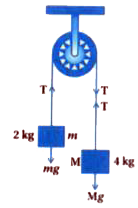As shown in figure, masses of 2 kg and 4kg are tied to two ends of a wire passed over a pulley. Cross-sectional area of wire is 2cm2. Calculate longitudinal strain produced in wire. (g=10ms−2Y=2×1011Pa
 Solution in Gujrati
Solution in Gujrati

Here, M=4kg
m=2kg
g=10ms−2
y=2×1011Pa
a=?
A=2cm2
=2×10−4m2
T=?
Δll=?
If common acceleration of both masses is a and tension in wire = T, using equation of motions,
Mg−T=Ma ...(1)
T−mg=ma ...(2)
∴ Adding eq. (1) and (2).
(M−m)g=(M+m)a
∴(4−2)×10=(4+2)×a
∴206=a
∴a=103ms−2
Putting a=103ms6(−2) in eq. (2)
T=mg+ma=2×10+2×103
∴T=803N
∴ Stress σ=FA=TA=803×2×10−4=43×105Nm2
∴Strainε=stressY
=43×105×12×1011=2.3×10−6
≈0.66×10−6
≈6.6×10−7
Topper's Solved these Questions
- MACHANICAL PROPERTIES OF SOLIDS BOOK - KUMAR PRAKASHANCHAPTER - MACHANICAL PROPERTIES OF SOLIDS EXERCISE - SECTION-C
66 Videos
- MACHANICAL PROPERTIES OF SOLIDS BOOK - KUMAR PRAKASHANCHAPTER - MACHANICAL PROPERTIES OF SOLIDS EXERCISE - SECTION-D
29 Videos
- MACHANICAL PROPERTIES OF SOLIDS BOOK - KUMAR PRAKASHANCHAPTER - MACHANICAL PROPERTIES OF SOLIDS EXERCISE - SECTION-A TRY YOURSELF (VSQs)
40 Videos
- LAW OF MOTIONBOOK - KUMAR PRAKASHANCHAPTER - LAW OF MOTIONEXERCISE - (QUESTION PAPER) SECTION-D
1 Videos
- MECHANICAL PROPERTIES OF FLUIDS BOOK - KUMAR PRAKASHANCHAPTER - MECHANICAL PROPERTIES OF FLUIDS EXERCISE - QUESTION PAPER (SECTION -C)
3 Videos
Similar Questions
What is elasticity ? What is plastic body and plasticity?
View SolutionModulus of rigidity of an ideal liquid is ......
View SolutionWhat are solid bodies composed ?
View SolutionA 70 kg man stands in contact against the inner wall of a hollow cylindrical drum of radius 3 m rotating about its vertical axis with 200 rev/min. The coefficient of friction between the wall and his clothing is 0.15. What is the minimum rotational speed of the cylinder to enable the man to remain stuck to the wall (without falling) when the floor is suddenly removed ?
View SolutionGlycerine flows steadily through a horizontal tube of length 1.5m and radius 1.0 cm . If the amount of glycerine collected per second at one is 4.0×10−3kgs−1 , what is the pressure difference between the two ends of the tube ? (Density of glycerine =1.3×10103kgm−3 and viscosity of glycerine =0.83 Pa s). [ you may also like to check if the assumption of laminar flow in the tube is correct]
View SolutionA wire of length 1m is stretched by a force of 10N. The area of cross-section of the wire is 2 × 10^(–6) m^(2) and Y is 2 xx 10^(11) N//m^(2) . Increase in length of the wire will be -
View SolutionOne end of a steel wire is fixed to celling of an elevator moving up load of 10 g hange from other end. Area of cross-section of the wire Is 2 cm^(2) .Find the longitudinal strain in the wire (Take g = 10m//s^(2) and Y= 2 xx 10^(11) N//m^(2))
View SolutionA body of mass 1 kg is fastened to one end of a steel wire of cross- section area 3 xx 10^(-6)m^(2) and is rotated in horizantal circle of radius 20 cm with a constant speed 2 m//s . Find the elongation of the wire (Y= 2 xx 10^(11) N//m^(2))
View SolutionOne end of steel wire is fixed ti ceiling of an elevator moving up with an acceleration 2 m//s^(2) amd a load of 10 kg hangs from other end. Area of cross- section of the wire is 2cm^(2) .The longitudinal strain in the wire is (g= 10 m//s^(2) and Y= 2 xx 10^(11)Nm^(2)) .
View SolutionSpeed of a transverse wave on a straight wire ( mass 6.0 g, length 60 cm and area of cross - section 1.0 mm2 ) is 90ms−1. If the Young's modulus of wire is 16×1011Nm−2 , the extension of wire over its natural length is :
View SolutionA steel wire having cross-sectional area 2 mm^(2) is stretched by 20 N. Find the lateral strain produced in the wire Y_("steel") = 2 xx 10^(11) Nm^(-2), sigma = 0.391
View SolutionA steel wire having cross-sectional area 1.5 mm^(2) when stretched by a load produces a lateral strain 1.5 xx 10^(-5) . Calculate the mass attached to the wire. ( Y_("steel") = 2xx 10^(11) N//m^(2) , Poisson's ration sigma = 0.291, g = 9.8 m//s^(2) )
View SolutionWhat will be the increase in length of a wire of length 10 m undergoing a strain of 0.001%? If the cross sectional area of the wire 2mm2 and the load applied at its end is 1 kg, then calculate the stress developed in dyn.cm−2.
View SolutionA wire 10 m long has a cross-sectional area 1.25 xx 10^(-4) m^(2) . It is subjected to a load of 5 kg. If Young's modulus of the material is 4 xx 10^(10) N m^(-2) , calculate the elongation produced in the wire. Take g = 10 ms^(-2)
View SolutionA mass of 15 kg is tied at the end of a steel wire of the length lm. It is whirled in a vertical plane with angular velocity 1 rad/s. Cross sectional area of the wire is 0.06 cm^(2). Calculate the elongation of the wire when the mass is at its lowest position. Y_("steel”) = 2 xx 10 ^(11) Nm ^(-2)
View Solution
